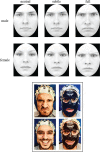Neural measures of the causal role of observers' facial mimicry on visual working memory for facial expressions
- PMID: 30365020
- PMCID: PMC6277745
- DOI: 10.1093/scan/nsy095
Neural measures of the causal role of observers' facial mimicry on visual working memory for facial expressions
Abstract
Simulation models of facial expressions propose that sensorimotor regions may increase the clarity of facial expressions representations in extrastriate areas. We monitored the event-related potential marker of visual working memory (VWM) representations, namely the sustained posterior contralateral negativity (SPCN), also termed contralateral delay activity, while participants performed a change detection task including to-be-memorized faces with different intensities of anger. In one condition participants could freely use their facial mimicry during the encoding/VWM maintenance of the faces while in a different condition participants had their facial mimicry blocked by a gel. Notably, SPCN amplitude was reduced for faces in the blocked mimicry condition when compared to the free mimicry condition. This modulation interacted with the empathy levels of participants such that only participants with medium-high empathy scores showed such reduction of the SPCN amplitude when their mimicry was blocked. The SPCN amplitude was larger for full expressions when compared to neutral and subtle expressions, while subtle expressions elicited lower SPCN amplitudes than neutral faces. These findings provide evidence of a functional link between mimicry and VWM for faces and further shed light on how this memory system may receive feedbacks from sensorimotor regions during the processing of facial expressions.
Figures





Similar articles
-
Race perception and gaze direction differently impair visual working memory for faces: An event-related potential study.Soc Neurosci. 2016;11(1):97-107. doi: 10.1080/17470919.2015.1040556. Epub 2015 May 7. Soc Neurosci. 2016. PMID: 25874908
-
Interhemispheric ERP asymmetries over inferior parietal cortex reveal differential visual working memory maintenance for fearful versus neutral facial identities.Psychophysiology. 2011 Feb;48(2):187-97. doi: 10.1111/j.1469-8986.2010.01046.x. Psychophysiology. 2011. PMID: 20557488
-
Individual differences in anxiety predict neural measures of visual working memory for untrustworthy faces.Soc Cogn Affect Neurosci. 2014 Dec;9(12):1872-9. doi: 10.1093/scan/nst189. Epub 2014 Feb 3. Soc Cogn Affect Neurosci. 2014. PMID: 24493843 Free PMC article.
-
The contralateral delay activity as a neural measure of visual working memory.Neurosci Biobehav Rev. 2016 Mar;62:100-8. doi: 10.1016/j.neubiorev.2016.01.003. Epub 2016 Jan 21. Neurosci Biobehav Rev. 2016. PMID: 26802451 Free PMC article. Review.
-
Visual Working Memory for Faces and Facial Expressions as a Useful "Tool" for Understanding Social and Affective Cognition.Front Psychol. 2019 Oct 22;10:2392. doi: 10.3389/fpsyg.2019.02392. eCollection 2019. Front Psychol. 2019. PMID: 31695663 Free PMC article. Review.
Cited by
-
Altering Facial Movements Abolishes Neural Mirroring of Facial Expressions.Cogn Affect Behav Neurosci. 2022 Apr;22(2):316-327. doi: 10.3758/s13415-021-00956-z. Epub 2021 Oct 12. Cogn Affect Behav Neurosci. 2022. PMID: 34642896 Free PMC article.
-
Facial mimicry interference reduces working memory accuracy for facial emotion expressions.PLoS One. 2024 Jun 26;19(6):e0306113. doi: 10.1371/journal.pone.0306113. eCollection 2024. PLoS One. 2024. PMID: 38924006 Free PMC article.
-
Degenerate pathway for processing smile and other emotional expressions in congenital facial palsy: an hdEEG investigation.Philos Trans R Soc Lond B Biol Sci. 2022 Nov 7;377(1863):20210190. doi: 10.1098/rstb.2021.0190. Epub 2022 Sep 21. Philos Trans R Soc Lond B Biol Sci. 2022. PMID: 36126673 Free PMC article.
-
"When You're Smiling": How Posed Facial Expressions Affect Visual Recognition of Emotions.Brain Sci. 2023 Apr 16;13(4):668. doi: 10.3390/brainsci13040668. Brain Sci. 2023. PMID: 37190633 Free PMC article.
-
Alterations in working memory maintenance of fearful face distractors in depressed participants: An ERP study.J Vis. 2023 Jan 3;23(1):10. doi: 10.1167/jov.23.1.10. J Vis. 2023. PMID: 36652236 Free PMC article.
References
-
- Balconi M., Canavesio Y. (2013). High-frequency rTMS improves facial mimicry and detection responses in an empathic emotional task. Neuroscience, 236, 12–20. doi:https://doi.org/10.1016/j.neuroscience.2012.12.059. - PubMed
-
- Balconi M., Canavesio Y. (2016). Is empathy necessary to comprehend the emotional faces? The empathic effect on attentional mechanisms (eye movements), cortical correlates (N200 event-related potentials) and facial behaviour (electromyography) in face processing. Cognition & Emotion, 30(2), 210–24. doi:https://doi.org/10.1080/02699931.2014.993306. - PubMed
-
- Baron-Cohen S., Wheelwright S. (2004). The empathy quotient: an investigation of adults with asperger syndrome or high functioning autism, and normal sex differences. Journal of Autism and Developmental Disorders, 34(2), 163–75. doi:https://doi.org/10.1023/B:JADD.0000022607.19833.00. - PubMed

